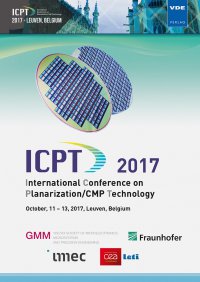Effect of Flow Rate and Concentration on Filtration Efficiency of Colloidal Abrasives
Konferenz: ICPT 2017 - International Conference on Planarization/CMP Technology
11.10.2017 - 13.10.2017 in Leuven, Belgium
Tagungsband: ICPT 2017
Seiten: 6Sprache: EnglischTyp: PDF
Persönliche VDE-Mitglieder erhalten auf diesen Artikel 10% Rabatt
Autoren:
Wu, Mia; Lee, James; Wang, Henry; Hsiao, Steven; Shie, Bob (Entegris. Ltd., No. 6-7, Du Xing Road Hsinchu City 30072, Taiwan R.O.C.)
Yang, HJ (Entegris Korea Ltd., KANC 13F, 109 Gwanggyo-ro, Yeongtong-gu Suwon-si, Gyeonggi-do, 16229, Korea)
Inhalt:
Sub 14 nm technology nodes require increased chemical, mechanical and polishing (CMP) steps compared to previous generation semiconductor devices. For both bulk slurry manufacturers and integrated device manufacturers (IDM), it's critical to reduce large particle counts (LPC), which are undesirable during the CMP process and can create micro-scratches that lead to wafer defects. Slurry filters strive to remove LPC that are generated during the mixing process and formed as gels or agglomerates while maintaining the overall particle size distribution of working particles. Efficient filtration of large particles reduces the number of micro-scratches during final wafer polishing and enables higher wafer yields. To achieve a very low LPC level, filters are used in multiple locations. These locations are categorized as bulk, point-of-tool (PoT) and point-of-dispense (PoD). The right choice of filtration product at each point of the liquid slurry delivery system, which have different slurry concentrations and flow rate requirements, will affect the outcome. Many studies in slurry filtration have shown the importance of media structure and material characteristics to improve filtration efficiency. However, none addresses the importance of flow rate and concentration conditions together. This study focuses on understanding the effect of these critical factors on filtration efficiency by evaluating two nanofiber NMB (nano-melt-blown) Entegris CMP filters (NMB01 100nm and NMBA5 50nm) with colloidal ceria (CeO2) and silica (SiO2) abrasives. The importance of optimization of abrasive concentration, flow rate and filtration media is demonstrated. Keywords: chemical mechanical planarization; cmp; filtration; retention; ceria; silica; abrasive; slurry


